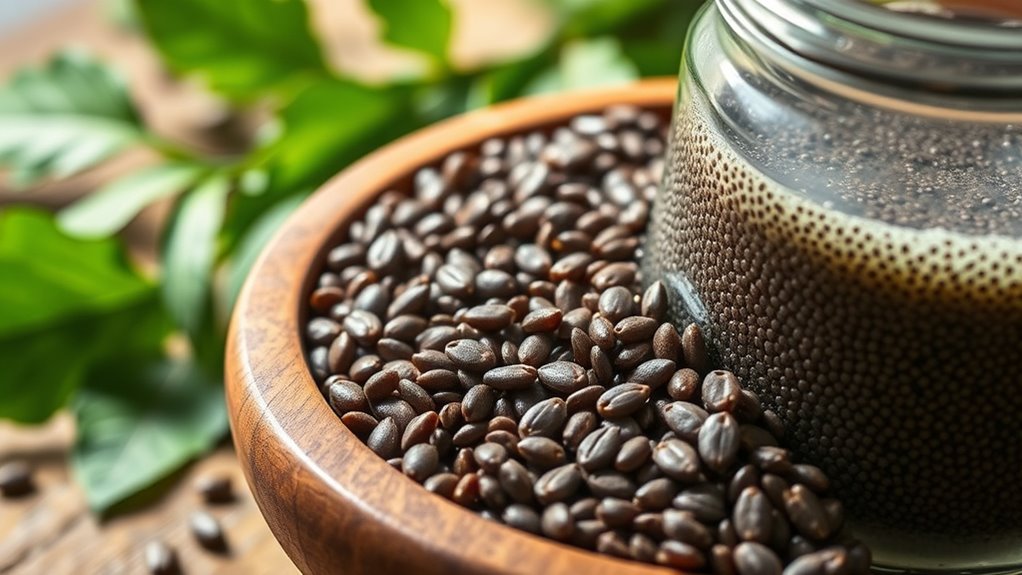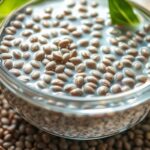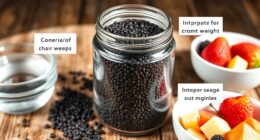FODMAPs are fermented sugars in certain foods that can cause gas, bloating, and discomfort, especially if your gut microbiota isn’t balanced. Chia seeds are considered low-FODMAP because they contain minimal fermentable carbs, producing less gas during digestion. Their high fiber content supports beneficial bacteria and promotes a healthy gut, reducing bloating. Keep exploring to discover how chia seeds can fit into a gut-friendly diet and help manage your symptoms effectively.
Key Takeaways
- Chia seeds contain minimal fermentable carbohydrates, classifying them as a low-FODMAP food.
- Their low fermentability produces less gas during digestion, reducing bloating and discomfort.
- The soluble fiber in chia seeds supports beneficial gut bacteria, promoting overall gut health.
- Fermentation of chia seed fiber generates short-chain fatty acids that soothe and nourish the gut lining.
- Including chia seeds can help manage FODMAP-related symptoms due to their low-gas fermentation profile.

Have you ever wondered why certain foods trigger digestive discomfort? The answer often lies in how your body processes specific carbohydrates, especially those classified as FODMAPs. These short-chain sugars are poorly absorbed in the small intestine, which means they travel to your large intestine where they encounter your gut microbiota. This community of trillions of bacteria plays a vital role in the fermentation process, breaking down these carbohydrates and producing gases like hydrogen, methane, and carbon dioxide. The buildup of these gases is what causes bloating, cramps, and other uncomfortable symptoms, especially if your gut microbiota is sensitive or imbalanced.
Understanding this process helps explain why some foods are more problematic than others. When you consume high-FODMAP foods, they undergo fermentation in your gut, which can lead to increased gas and discomfort. But not all foods with FODMAPs are equally troublesome, and that’s where the fermentation process and the composition of your gut microbiota come into play. Some people’s microbiota is more adept at handling certain carbohydrates, leading to fewer symptoms. Conversely, a disrupted or imbalanced gut microbiota can amplify the effects of FODMAPs, making foods that are normally tolerated more problematic.
This is where the concept of low-FODMAP foods, like chia seeds, becomes particularly relevant. Chia seeds are considered a low-gas option because they contain minimal fermentable carbohydrates. When you include them in your diet, they produce less gas during fermentation, reducing the likelihood of bloating and discomfort. Additionally, chia seeds are rich in soluble fiber, which can support a healthy gut microbiota by acting as a prebiotic. This can help promote beneficial bacteria that are better at digesting other foods and maintaining overall gut health. The fermentation of these fibers produces short-chain fatty acids, which nourish your gut lining and can even reduce inflammation.
Frequently Asked Questions
Are Chia Seeds Suitable for All Low-Fodmap Diets?
You might wonder if chia seeds suit all low-FODMAP diets. Their versatility makes them a popular choice, but their FODMAP content depends on serving size. Small portions, like one tablespoon, are generally low in FODMAPs and suitable for most. However, larger servings could increase FODMAP levels, so it’s best to monitor your intake and consult a dietitian. Overall, chia seeds can fit into a low-FODMAP plan when eaten mindfully.
How Much Chia Seeds Can I Consume Daily on a Low-Fodmap Plan?
You might find it interesting that sticking to the right portion sizes makes a difference. For your daily intake, aim for about 1-2 tablespoons of chia seeds, which typically contain low FODMAP levels. Keep in mind, larger portion sizes could trigger symptoms. So, measure carefully and listen to your body, ensuring your daily intake stays within that recommended range for a low-FODMAP plan.
Do Chia Seeds Cause Any Digestive Discomfort Despite Being Low-Fodmap?
You wonder if chia seeds might cause digestive discomfort despite being low-FODMAP. If you have digestive sensitivity, you should consider seed soaking, as it helps reduce potential irritants and makes digestion easier. While chia seeds are generally gentle, some people might experience mild bloating or gas. Paying attention to your body’s response and soaking your seeds properly can help prevent discomfort and make chia seeds a safe, nutritious addition to your diet.
Can Chia Seeds Replace Other High-Fodmap Fiber Sources?
Imagine your gut as a vibrant garden, thriving with healthy plants. Chia seeds, with their seed versatility, can be your go-to for fiber substitution, replacing high-FODMAP sources. They swell like tiny balloons, delivering gentle, soothing fiber that fuels your digestion without causing discomfort. By incorporating chia seeds, you nurture your gut’s health, embracing a simple, effective way to enjoy fiber while keeping your digestive garden happy and flourishing.
Are There Any Storage Tips to Prevent Chia Seed Spoilage?
To prevent chia seed spoilage, you should follow some simple storage tips. Keep them in an airtight container in a cool, dark place, like your pantry, to prevent exposure to heat and light. If you buy in bulk, consider storing some in the refrigerator or freezer for longer shelf life. Always check for any signs of spoilage, such as an off smell or mold, and reseal tightly after use.
Conclusion
Now that you know about FODMAPs and why chia seeds are your low-gas ally, you’re armed with a secret weapon for calmer digestion. Think of chia seeds as tiny ships sailing smoothly through your gut’s choppy waters, helping you avoid the storm of bloating and gas. With this knowledge, you can navigate your diet like a savvy sailor, steering clear of digestive storms and enjoying the calm, peaceful seas of comfort and well-being.
















